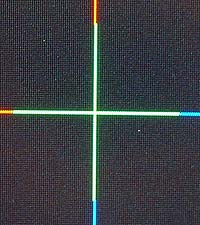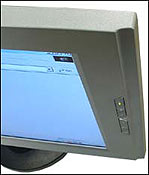TFT Display Evaluation Notes
| PCstats TFT Display Evaluation
Criteria: |
|
We
evaluate the quality of TFT displays with the help of a program called
Nokia Monitor Test. The software application displays a range of colours
and test patterns that can help diagnose just about any visual problems or
defects a TFT display may contain.
It can also be a very useful tool for
properly adjusting a display to the optimal settings. The software
consists of eleven tests which can be run in steps as adjustments are made
to the OSD. As the tests are run we look for the following problems, only
one of which should be inoperable (broken pixel).
Broken Pixels: What we class as a 'broken pixel' can
fall under any one of the following circumstances: Pixel always on (any
colour), pixel always off, pixel unable to display a shade (red, green,
blue, black, white), pixel shown colour gradient.
Pixel Clock: If the number of dot clocks within one
horizontal synch are not properly configured the screen will appear to
drift or vertical stripes may be generated. This should be correctable by
the on screen menu.
Phase: If the phase of the display data and dot clock
are not correctly tuned the screen can flicker, or text be displayed
blurry. For example text may appear dithered, or when looking at a test
pattern of a one-pixel black, one-pixel white checkerboard pattern the
pattern may be distorted. This should be correctable by the on screen
menu.
Response Time: We look for any streaking associated
with moving a full page of text up or down quickly. Displays with slower
refresh rates tend to show some degree of image streaking or text
discoloration which can be distracting.
Stand Stability: TFT displays are fragile components and the
stand should offer adequately stable support as well as be easily
adjustable.
We deduct marks for quality control if there are any predominant
broken pixels in a display. While many manufacturers may consider a
few broken pixels acceptable, we believe the high cost of TFT displays
should translate into a clear and unblemished image. |
|
| Display Test System
Configuration: |
| Video Card: |
MSI GeForce 3 Ti200 (MS8850) |
| Operating System: |
MS
Windows XP |
| Display Settings: |
Color Temp: 6500 Kelvin
Resolution: 1280x1024
pixels
Frequency: 60Hz
Colour: 32
Bit | |
| Display
Resolutions: |
| Resolution |
Freq Hor. |
Freq Ver. |
Standard |
| 720X400 |
31.5 |
70 |
VGA |
| 640x480 |
31.5 |
60 |
VGA |
| 640x480 |
37.5 |
75 |
VGA |
| 640x480 |
43.3 |
85 |
VGA |
| 800x600 |
46.8 |
75 |
VESA |
| 800x600 |
53.6 |
85 |
VESA |
| 1024x768 |
48.3kHz |
60Hz |
XGA |
| 1024x768 |
60.0kHz |
75Hz |
XGA |
| 1024x768 |
68.7kHz |
84Hz |
XGA |
| 1280x1024 |
63.98kHz |
60Hz |
VESA |
| 1280x1024 |
79.90kHz |
75Hz |
VESA | |
| LCD Display Test |
Overall |
Test Notes and Observations |
|
| Geometry: |
10 |
Excellent picture geometry at the 171B's native
1280x1024 resolution. LCD displays as a
general rule never have problems displaying straight lines unless they are badly misconfigured.
|
| Brightness and Contrast: |
10 |
Very subtle changes are visible from 1% to 9%
white as they should be. The 20% to 100% shading bars are nicely
transitioned and 100% white is very bright (400:1 contrast ratio remember).
Pure black has always been difficult to reproduce on an LCD display, but
the 171B manages it to the norm.
|
| HV Test: |
10 |
This test is more applicable to CRT displays than
it is to an LCD. How ever since it forces the display to show a full
screen of black or white, while maintaining a solid white line around the
outside it is a good indicator of refresh rates on both the display and
pixel levels. On test two, where a full screen of white is
blinked on and off, the pixel response times are tested fully. If you watch this test
for a minute or so, you can actually see the 60Hz timing blip move slowly
down the screen. The pixel refresh rate is 25ms.
|
| Colour: |
10 |
The white test screen is bright and very
consistent over the full screen real estate. There are no visible dark
patches, or banding of any type at the edges. The red test screen is very
bright and lush, the green is a bit pale, but bright, and the blue screen
test is smooth and intense as it should be.
|
| Convergence: |
9.8 |
No monitor ever gets 10 out of 10 in this test on
the vertical plane. The grid test patterns in RGB illustrate the worst
case situations when different coloured pixels must work
closely together, and since they comprise different parts of a pixel they do not line up exactly (see
vertical line in image below). The purple test grid is pretty harsh,
but the 171B fairs pretty well, even on close inspection.
The yellow and light blue test grids are almost perfect, and the RGB is
shown below.

|
| Focus: |
10 |
Excellent, all patterns are clearly visible and defined in both the
horizontal and vertical axis.
|
| Resolution: |
10 |
Resolution was also excellent
at the native 1280x1024 resolution. The image scaling algorithm was very good at
non-native resolutions.
|
| Moire: |
10 |
Excellent, all test patterns were displayed properly and
without interference or 'walking lines'.
|
|
Other Evaluation Notes: |
9.7 |
The pixel refresh rate is 25ms, and there were no
broken pixels in the unit we tested. The stand was very stable, and we
didn't have any concerns about it tipping over. However, since it is
adjustable in the vertical axis, the stand is spring loaded. Lifting up
the unit allows the stand to extend fully, so it must be re-adjusted when placed
back down. There were no problems with Phase at
60Hz.
|
|
|
|
|
Final
Evaluation Notes & Conclusions

Compared to other displays in the 17" range we have reviewed, the 171B is one
of the most economical options. Retailing for around $800USD, the 171B offers
superb display attributes (400:1 contrast, 240cd/m2 brightness) and pixel
response times.
By removing all the extraneous features like DVI and integrating the power
supply directly into the unit, Samsung have shown us that they can offer
a very stylish silver monitor with an excellent LCD glass panel at relatively
'value' market prices.
The are really no perks with this display other than an
adjustable stand which offers users 90 degrees of rotation, and vertical height
adjustments. Is this really a useful feature? Well, I wouldn't put it
at the top of my list, but it does come
in handy, especially if you look at a lot of webpages, or
do a lot of typing. In realistic terms however, it is hard to break away
from the conception that we must always look at displays from the landscape
perspective.
So where the user is concerned, there are
some definite advantages to the ability to quickly tilt a display and look at
longer uninterrupted pages. Where this feature will probably find the most use
is in specialized business applications, where large spreadsheets, or demos need
that extra vertical real estate. Anyhow, apart from the standard Kensington lock
on the back of the panel there really isn't much in the way of extra features
with this LCD display - and that keeps the price down.
Personally, I'm most impressed with the LCD glass characteristics, as it is
these which make the greatest impression with users over time. The
excellent contrast and very good brightness ratings coupled with the 25ms
pixel response and wide viewing angles are a welcome sight.
In too many cases we usually see value market
displays retailing for low prices, but still packing tons of features. The only
way these prices are being supported is by going for lower quality LCD panels as
that is the single most expensive component in a LCD display.
Samsung have kind of turned that trait on its
head and integrated a very capable LCD glass with a display short on features.
While $800USD is still quite a lot of cash to spend on a 17" LCD display, it is
comparably low in the overall price group. When you consider that, the great LCD
glass used on the 171B, and the fact that this display is 65mm thick with the
screen real estate of a 19" CRT, you can see Samsung make a good case for
themselves. Bottom line, the 171B is an affordable display with very little in
the way of unnecessary extra features.
You tell us, do you think this LCD display is as good as we think it is? Come to the forums and let us know what
you think about it.
|
